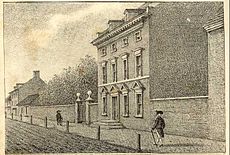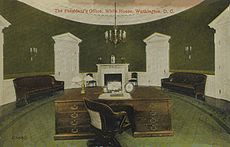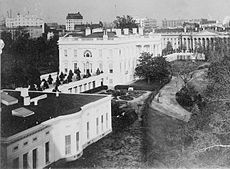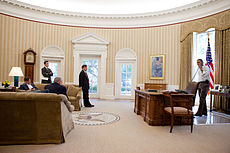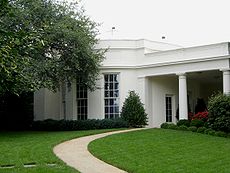- Oval Office
-
 President Barack Obama edits his remarks in the Oval Office prior to making a televised statement detailing the mission against Osama bin Laden, May 1, 2011.
President Barack Obama edits his remarks in the Oval Office prior to making a televised statement detailing the mission against Osama bin Laden, May 1, 2011.
 The Oval Office in 1981, during the administration of Ronald Reagan. President Reagan used the Resolute Desk, that President Jimmy Carter had returned to the White House. The rug from the Gerald R. Ford administration was replaced when the Reagans redecorated in 1988.
The Oval Office in 1981, during the administration of Ronald Reagan. President Reagan used the Resolute Desk, that President Jimmy Carter had returned to the White House. The rug from the Gerald R. Ford administration was replaced when the Reagans redecorated in 1988.
The Oval Office, located in the West Wing of the White House, is the official office of the President of the United States.
The room features three large south-facing windows behind the president's desk, and a fireplace at the north end. It has four doors: the east door opens to the Rose Garden; the west door leads to a private smaller study and dining room; the northwest door opens onto the main corridor of the West Wing; and the northeast door opens to the office of the president's secretary.
Presidents generally change the office to suit their personal taste, choosing new furniture, new drapery, and designing their own oval-shaped carpet to take up most of the floor. Paintings are selected from the White House’s own collection, or borrowed from other museums for the president’s term in office.
Contents
Cultural history
The Oval Office has become associated in Americans' minds with the presidency itself through memorable images, such as a young John F. Kennedy, Jr. peering through the front panel of his father's desk, President Richard Nixon speaking by telephone with the Apollo 11 astronauts during their moonwalk, and daughter Amy Carter bringing her Siamese cat Misty Malarky Ying Yang to brighten President Jimmy Carter's day.
Oval Office Addresses
An Oval Office Address, the television broadcast of a formal presidential speech from the office, is rare and reserved for occasions with a sense of gravity, as when President Kennedy presented news of the Cuban Missile Crisis, or President Ronald Reagan addressed the nation following the Space Shuttle Challenger Disaster, or President George W. Bush addressed the nation on the evening of September 11, 2001.
Antecedents
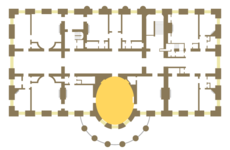 Location of the Yellow Oval Room on the second floor of the White House. A number of presidents used this as their private office or library.
Location of the Yellow Oval Room on the second floor of the White House. A number of presidents used this as their private office or library.
 The Yellow Oval Room as President Grover Cleveland's library and study, 1886. Note his use of the Resolute Desk.
The Yellow Oval Room as President Grover Cleveland's library and study, 1886. Note his use of the Resolute Desk.
Washington's Bow Window
George Washington never occupied the White House. He spent most of his presidency in Philadelphia, Pennsylvania, which served as the temporary national capital for 10 years, 1790–1800, while Washington, DC was under construction.
In 1790, Washington built a large, two-story, semi-circular addition to the rear of the President's House in Philadelphia, creating a ceremonial space in which the public would meet the President.[1] Standing before the three windows of this Bow Window, he formally received guests for his Tuesday afternoon levees, delegations from Congress and foreign dignitaties, and the general public at open houses on New Year's Day, the Fourth of July, and his birthday.
"Washington received his guests, standing between the windows in his back drawing-room. The company, entering a front room and passing through an unfolding door, made their salutations to the President, and turning off, stood on one side."[2]
The apsidal end of a room was a traditional site of honor, for a host, a potentate, or the magistrate in a basilica.
President John Adams occupied the Philadelphia mansion beginning in 1797, and used the Bow Window in the same manner as his predecessor for the first three years of his presidency.[3]
Curved foundations of Washington's Bow Window were uncovered during a 2007 archaeological excavation of the President's House site.[4][5]
White House
Architect James Hoban visited President Washington in Philadelphia in June 1792, and would have seen the Bow Window.[6] The following month, he was named winner of the design competition for The White House.
The "elliptic salon" at the center of the White House was the outstanding feature of Hoban's original plan. An oval interior space was a Baroque concept that was adapted by Neoclassicism. Oval rooms became popular in eighteenth century neoclassical architecture.[7]
In November 1800, John Adams became the first President to occupy the White House. He and his successor, President Thomas Jefferson, used Hoban's oval rooms in the same ceremonial manner that Washington had used the Bow Window, standing before the three windows at the south end to receive guests.[8]
Yellow Oval Room
During the 19th century, a number of presidents used the White House's second-floor Yellow Oval Room as a private office or library.
West Wing
The West Wing was the conception of President Theodore Roosevelt, brought about by his wife's idea that the second floor of the White House, then shared between bedrooms and offices, should be just a domestic space. Further, Roosevelt's proposed addition of offices and meeting rooms would enable him to demolish a dilapidated set of pre-Civil War greenhouses that had been constructed by President James Buchanan. Roosevelt moved the offices of the executive branch to the newly constructed wing in 1902. His own working office was rectangular in shape, located just west of the present Cabinet Room.
Taft Oval Office: 1909-29
President William Howard Taft built the West Wing's first Oval Office. Designed by Nathan C. Wyeth and completed in 1909, it was centered on the south side of the building, much as the oval rooms in the White House are. Taft intended it to be the center of his administration, and by locating it in the center of the West Wing, he could be more involved with the day-to-day operation of his presidency. The Taft Oval Office had simple Georgian Revival trim, and was likely the most colorful in history; the walls were covered in a vibrant seagrass green.[9]
Hoover Oval Office: 1930-33
On December 24, 1929, during President Herbert Hoover's administration, a fire damaged the West Wing, requiring substantial rebuilding. Hoover rebuilt the Oval Office in the same location, upgrading the quality of trim and having the first air conditioning installed.
FDR Oval Office: 1934-present
 Location of the Oval Office in the West Wing.
Location of the Oval Office in the West Wing.
 The Oval Office during the administration of Franklin D. Roosevelt. An early color photograph.
The Oval Office during the administration of Franklin D. Roosevelt. An early color photograph.
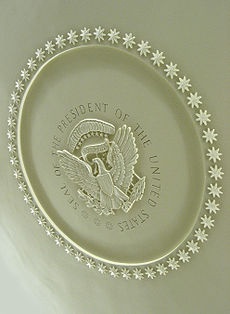 Plaster ceiling medallion installed in 1934 includes elements of the Seal of the President of the United States.
Plaster ceiling medallion installed in 1934 includes elements of the Seal of the President of the United States.
 President Obama at the Resolute Desk, August 19, 2009.
President Obama at the Resolute Desk, August 19, 2009.
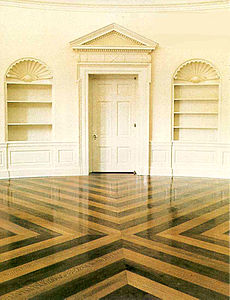 Oval Office floor, replaced during the administration of George W. Bush. Based on a 1933 design by Eric Gugler, the 2005 installation is arranged in a contrasting cross pattern of quarter sawn oak and walnut. Most of the floor is usually covered with an oval rug.
Oval Office floor, replaced during the administration of George W. Bush. Based on a 1933 design by Eric Gugler, the 2005 installation is arranged in a contrasting cross pattern of quarter sawn oak and walnut. Most of the floor is usually covered with an oval rug.
Dissatisfied with the size and layout of the West Wing, President Franklin D. Roosevelt engaged a staff architect, Eric Gugler, to redesign it in 1933. The modern Oval Office was built at the West Wing's southeast corner, offering FDR, who was physically disabled and used a wheelchair, more privacy and easier access to the residence. He and Gugler devised a room architecturally grander than the previous two rooms, with more robust Georgian details: doors topped with substantial pediment hoods, bookcases set into niches, a deep bracketed crown molding, and a ceiling medallion of the Presidential Seal. In small ways, hints of Art Moderne can be seen, especially in the representation of the eagle in the ceiling medallion. FDR and Gugler worked closely together, often over breakfast, with Gugler sketching the president's ideas. One notion resulting from these sketches that has become fixed in the layout of the room's furniture, is that of two high back chairs in front of the fireplace. The public sees this most often with the president seated on the left, and a visiting head of state on the right. This allowed FDR to be seated, with his guests at the same level, de-emphasizing his inability to stand on his own accord. Construction of the modern Oval Office was completed in 1934.
Decoration
Most recent presidents have hung a portrait of George Washington over the mantel on the north end of the room. A tradition of displaying potted Swedish ivy (Plectranthus verticillatus) atop the mantel goes back to the administration of John F. Kennedy, and the current plants were rooted from the original plant. A series of bronze sculptures of horses and Western themes by Frederic Remington are often displayed in the room. A large tall-case clock, commonly called a grandfather clock, built in Boston by John and Thomas Seymour, c. 1795-1805, stands in the northeast portion of the room.
Oval Office carpet
The carpet of the Oval Office bears the Seal of the President. President Harry S Truman's oval carpet was the first to incorporate the presidential seal. In Truman's carpet, the seal was represented monochromatically through varying depths of the cut pile. His carpet was used in the Eisenhower and Kennedy administrations. In recent years most administrations have created their own rug, working with an interior designer and the Curator of the White House.
Resolute Desk
Many presidents have used a large partners' desk called the Resolute Desk, so named because it was made from the timbers of the British frigate HMS Resolute. The ship was frozen in Arctic ice and abandoned, but later found and freed by American seamen. It was refurbished and presented as a gift from the United States to Queen Victoria of the United Kingdom in 1856. When the British ship was decommissioned in 1879, Queen Victoria ordered twin desks made from its timbers, keeping one and presenting the other as a gift to President Rutherford B. Hayes in 1880.
A number of presidents used it as their private office desk in the Yellow Oval Room and elsewhere. President Franklin D. Roosevelt ordered the kneehole panel with the Presidential Seal added, but work was not completed until after his 1945 death in office.
First Lady Jacqueline Kennedy had the desk restored, and was the first to place it in the Oval Office. Following the 1963 assassination of President John F. Kennedy, it toured the country as part of a traveling exhibit for the Kennedy Presidential Library, and then was lent to the Smithsonian Institution. President Jimmy Carter returned the desk to the Oval Office in the 1970s. Since then, Presidents Ronald Reagan, Bill Clinton, George W. Bush and Barack Obama have also used it as their Oval Office desk.
The Resolute Desk is one of five desks ever used in the Oval Office.
Redecoration
A tradition evolved in the latter part of the twentieth century of each new administration redecorating the office to the President's liking. A new administration usually selects an oval carpet, new drapery, the paintings on the walls, and some furniture. Most incoming presidents continue using the rug of their predecessor until their new one is installed. The retired carpet very often is then moved to the presidential library of the president for whom it was made.
The redecoration of the Oval Office is usually coordinated by the First Lady's office in the East Wing, working with an interior designer and the White House Curator. Art may be selected from the White House collection, or may be borrowed for the length of an administration. President Bill Clinton borrowed a bronze sculpture of The Thinker by Auguste Rodin from a museum. President George W. Bush borrowed two oil paintings, A Charge to Keep by W.H.D. Koerner (owned by Bush), and Rio Grande by Tom Lea (on loan from the El Paso Museum of Art).[10]
Alterations
Since the present Oval Office's construction in 1934 during the administration of President Franklin Delano Roosevelt the room has remained mostly unchanged architecturally. More than any president, FDR left an impression on the room and its use. Doors and window frames have been modified slightly. A screen door on the east wall was removed after the installation of air conditioning. During the Cold War, window panes were outfitted with small vibrators when it was learned that the Soviets had developed a means of reading the effect of voice sound waves on glass panes. President Lyndon B. Johnson's row of wire service teletype machines on the southeast wall required cutting plaster and flooring to accommodate wiring. The Georgian style plaster ornament has been cleaned to remove accumulated paint, and a series of electrified wall sconces have come and gone.
Though some presidents have chosen to do day-to-day work in a smaller study just west of the Oval Office, most use the actual Oval Office for work and meetings. Traffic from the large numbers of staff, visitors, and pets over time takes its toll. There have been four sets of flooring in the Oval Office. The original floor was made of cork installed over soft wood; however, President Dwight D. Eisenhower was an avid golfer and damaged the floor with his golf spikes. Johnson had the floor replaced in the mid-1960s with wood-grain linoleum. In 1982, President Ronald Reagan had the floor replaced with white pine and oak in a cross parquet pattern similar in design to Eric Gugler's 1933 sketch, which had never been installed. In August 2005, the floor was replaced again under President George W. Bush, in nearly the same pattern as the Reagan floor, but replacing the soft white pine with walnut.
Conservation
In the late 1980s a comprehensive assessment of the entire house, including the Oval Office, was made as part of the National Park Service's Historic American Building Survey (HABS). Detailed photographs and measured drawings were made documenting the interior and exterior and showing even slight imperfections. A checklist of materials and methods was generated for future conservation and restoration.
Dimensions
Dimensions US SI Major axis (north-south) 35' 10" 10.9 m Minor axis (east-west) 29' 8.8 m Height 18' 6" 5.6 m Line of rise (the point at which the ceiling starts to arch) 16' 7" 5.0 m Approximate Oval Circumference 102' 5" 31.2 m Approximate Area 816.2 sq ft 75.8 sq m The ratio of the major axis to the minor axis is 10.9/8.8 (i.e. about 1.24).
Gallery
-
President Barack Obama in the Oval Office, October 20, 2009.
-
President Barack Obama plays golf in the Oval Office with US Senators and Congressmen, a tradition harking back to the tenure of Lyndon Baines Johnson
-
The Oval Office from above in 2001, during the administration of George W. Bush. President Bush chose a more muted color palette than his predecessor, using shades of taupe, celadon and navy. He and Mrs. Bush worked with interior decorator Ken Blasingame on the design of the office.
-
One of many hand-shake photos in front of the fireplace. The President sitting to the viewer's right, the guest to the left. One of the rare images where there is fire in the fireplace (March 2003, the guest is Paul Kagame.)
-
The Oval Office in 1999, during the administration of Bill Clinton. President Clinton's office was designed by Arkansan Kaki Hockersmith, who used a vibrant color palette of cream, gold, crimson and sapphire blue.
-
The Oval Office in 1988, during the administration of Ronald Reagan. First Lady Nancy Reagan contributed to the design of her husband's Oval Office rug and the placement of furniture.
-
The Oval Office during the administration of Gerald R. Ford. President Ford used the office as his primary workspace. His successor, President Jimmy Carter, brought back the Resolute Desk, but did not change the rug or drapery.
-
The Oval Office in 1973, during the administration of Richard M. Nixon. President Nixon used an office in the Executive Office Building as his primary workspace. Here, he is playing golf with comedian Bob Hope.
See also
- 10 Downing Street - Official Residence and Office of the Prime Minister of the United Kingdom.
- Palais de l'Élysée - Official Residence and Office of the President of the French Republic.
- Langevin Block - Canadian Prime Minister's Office and Privy Council
- Perdana Putra - Malaysian Prime Minister's Complex Office
- The Lodge (Australia) - Official Residence of the Prime Minister of Australia
- Los Pinos - Official Residence and Office of the President of Mexico
References
- ^ Why is the Oval Office oval? from White House Historical Association.
- ^ "Recollections of Judge John B. Wallace," Pennsylvania Magazine of History and Biography, vol. 2 (1878), p. 175.
- ^ David McCullough, John Adams (New York: Simon & Schuster, 2001), p. 490.
- ^ A Window with Its Place in History Philadelphia Inquirer, May 9, 2007.
- ^ Photos of the archaeology.
- ^ "There can be little doubt that in Washington's bow can be found the seed that was later to flower in the oval shape of the Blue Room." William Seale, The President's House, A History (Washington, D. C., 1986), 8.
- ^ It is considered likely that Hoban was influenced by the elliptical chamber at Castle Coole in County Fermanagh, Northern Ireland. That room has identical dimensions, and includes the two recessed niches found in Hoban's original design for the Blue Room.
- ^ William Seale, "James Hoban: Builder of the White House," in White House History no. 22 (Spring 2008), pp. 8-12.
- ^ "The White House: Inside America's Most Famous Home" - CSPAN Documentary
- ^ "Mrs. Bush's Remarks for 100th Anniversary of the West Wing Symposium". - White House Historical Association. - November 13, 2002. - | Light from the Sky: A Tom Lea Retrospective, 1907–2001. - Mid-America Arts Alliance. - (Adobe Acrobat *.PDF document). - Retrieved: 2008-07-05
Further reading
- Portions of this article are based on public domain text from the White House.
- The White House: An Historic Guide. White House Historical Association and the National Geographic Society: 2001. ISBN 0-912308-79-6.
- Abbott James A., and Elaine M. Rice. Designing Camelot: The Kennedy White House Restoration. Van Nostrand Reinhold: 1998. ISBN 0-442-02532-7.
- Clinton, Hillary Rodham. An Invitation to the White House: At Home with History. Simon & Schuster: 2000. ISBN 0-684-85799-5.
- Monkman, Betty C. The White House: The Historic Furnishing & First Families. Abbeville Press: 2000. ISBN 0-7892-0624-2.
- Ryan, William and Desmond Guinness. The White House: An Architectural History. McGraw Hill Book Company: 1980. ISBN 0-07-054352-6.
- Seale, William. The President's House. White House Historical Association and the National Geographic Society: 1986. ISBN 0-912308-28-1.
- Seale, William, The White House: The History of an American Idea. White House Historical Association: 1992, 2001. ISBN 0-912308-85-0.
- West, J.B. with Mary Lynn Kotz. Upstairs at the White House: My Life with the First Ladies. Coward, McCann & Geoghegan: 1973. SBN 698-10546-X.
External links
- Oval Office historical photo essay
- Pictures of the Oval Office during different presidencies (1909–2005)
- Washington Post: "Inside the Real West Wing"
- Oval Office and Presidential desks
- White House Museum online tour: the Oval Office
- The Oval Office on Whitehouse.gov
- Google Sketchup 3D Model
- 2010 Oval Office Makeover
- An Office Fitted for a President – slideshow by The New York Times
Executive Residence BasementBasementBlue Room • Cross Hall • East Room • Entrance Hall • Family Dining Room • Grand Staircase • Green Room • Red Room • South Portico • State Dining Room • Chief UsherCenter Hall • Dressing Room • East Bedroom • East Sitting Hall • Family Kitchen • Lincoln Bedroom • Lincoln Sitting Room • President's Bedroom • President's Dining Room • Private Sitting Room • Queens' Bedroom • Queens' Sitting Room • Treaty Room • Truman Balcony • West Bedroom • West Sitting Hall • Yellow Oval RoomCenter Hall • Diet Kitchen • Linen Room • Music Room • Sun Room • Work-out Room


West Wing Cabinet Room • Executive Office • Oval Office • Press Briefing Room • Roosevelt Room • Situation RoomEast Wing Grounds Streets 15th Street • 17th Street • Constitution Avenue • E Street • East Executive Avenue • H Street NW • Hamilton Place • Jackson Place • Madison Place • Pennsylvania Avenue • State Place • West Executive AvenueAnnex Categories:- Rooms in the White House
- Georgian Revival architecture
Wikimedia Foundation. 2010.

